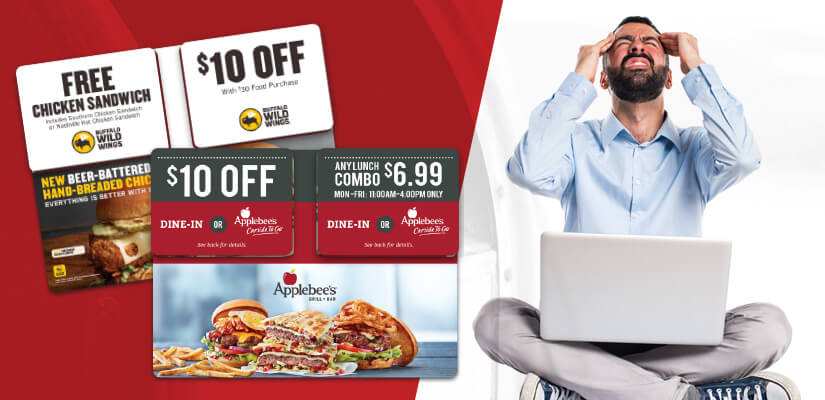And we can prove it.
Digital & Direct Mail Are Both Important
Don’t get me wrong. Both digital marketing and direct mail marketing are important for your restaurant. I’m not here to tell you that you should forget about digital and only worry about direct mail marketing. That’s not good either.
People are online and you should be where people are.
I’m here to tell you that with an effective direct mail campaign, you can outperform any digital marketing campaign when we take a look at the numbers.
Direct Mail vs Digital Marketing
Direct mail and digital marketing serve different purposes. One shouldn’t be the sole source of your marketing efforts over the other.
Again, people are online. You should be online.
People also check mailboxes. You should be there too.
With that being said, if you’re looking for that extra push for the holidays, that quarterly goal, or even just trying to beat last month, here are a few statistics between the two mediums that you should take into account.
Clickthrough Rate (CTR)
In other words, how many people engage with your ad?
The food & drink industry average click-through-rate on Facebook comes in at 1.2%1, but it has a much higher click-through-rate with Google Ads at 4.76%2. This means that 1.2% of people who see these ads on Facebook and 4.76% on Google click on an ad after seeing it. If 5,000 people see your ad, 60 people will click it on Facebook and 238 on Google.
Keep in mind, that doesn’t mean they’ll follow through and come to your restaurant.
%
Social Media
%
Google Ads
%
Direct Mail
Open rate isn’t quite the same as people checking their mail. But 98% of people check their mailbox daily. That means with the right piece that’s sure to stand out, we know all of your customers will see it.
From here, the customer has two options:
- Throw the piece away.
- Bring it into the restaurant.
If they bring it into your restaurant, that’s a conversion. Either way, the engagement was made because they had to look and touch the piece. Out of 5,000 deliveries, it’s safe to say 4,900 people will make a decision with your postcard.
Cost-per-Click (CPC)
When those users do click on your Facebook or Google ad, it will cost you on average $0.42 per click on Facebook1 and $1.25 on Google2.
If we do the math, a campaign that gets you 5,000 clicks would generally cost you $2,100 on social media and $6,250 on Google Ads.
It costs just about $0.50 per piece on a 5,000 piece mailer with a saturation list. Since we’re delivering the pieces to in-market customers, we can assume that each piece the 98% of the population engages with would count as a “click” in the direct mail world.
That means a 5,000 piece campaign would cost $2,500 (compared $2,100 for social media and $6,250 for Google Ads).
Conversion Rate / Leads Tracked
Out of those 5,000 that clicked on your Facebook and Google Ads, about 3.98% of them will claim the offer through Facebook1 but only 1.93% will do so on Google2. Since this isn’t an exact comparison with bringing in a coupon from a piece of mail, we’ll assume this would be similar.
That means only 199 people would come in from Facebook and 97 people would come in from Google Ads based on the hypothetical 5,000 click campaign we’ve set.
%
Social Media
%
Google Ads
%
Direct Mail
This is where the numbers start to matter more. If we send out 5,000 postcards, our typical restaurant response rate hits 10%. That’s 10% of recipients bringing in the postcard or a perforated coupon from the postcard.
10% of 4,900 engaged pieces would be 490 customers. If this were social media, we’d have a conversion rate of 3.98% (199 customers), and only 1.93% (97 customers) for Google Ads.
Cost per Acquisition / Customer
The cost-per-acquisition is essentially how much it costs in advertising spend on Facebook or Google to acquire a customer.
Based on our example here with a 5,000 click campaign, Facebook sits at $10.55 per lead — that’s 5,000 clicks times $0.42 per click, then divided by 199 customers according to our 3.98% conversion rate.
By that same logic, Google in our example will cost about $64.43 per customer. Based on the recorded industry benchmarks below, our example is pretty spot on with reality.
$6.31 is our average cost per lead for our restaurant clients based on the cost of a postcard campaign. But let’s use the example we’ve been using:
A 10% return rate on a 5,000 piece postcard campaign would yield 500 customers (leads). 5,000 pieces at $0.50 per piece would come out to a $2,500 campaign. 500 customers for $2,500 comes to $5.00 per customer, which of course is lower than the $6.31 average we see. Though it’s an average, it’s worth it to point out this number changes based on the targeting strategy, the delivery method, type of postcard, and offers used.
We’ve seen cost per customers as high as $10 and as low as $1.50 with our direct mail marketing.
Which Will Make Your Restaurant More Money?
There are a lot of factors that go into which medium will give your restaurant the best return on your investment, including the cost of your offer.
It’s also going to matter what the average cost of your ticket is as well as the lifetime value of your customer.
What we were able to show in this article is that the cost per customer for direct mail can be much lower than marketing by digital means.
Now is the Best Time to Get into Customer Mailboxes!
It needs to be said — right now is the time to be seen in mailboxes. Fewer companies are using direct mail as a marketing method due to efforts being shifted digitally.
More ads are on computer and phone screens and less are in the mailbox, which means your postcard will stand out with much less competition.
Your competitors think direct mail is dying, but they’re wrong.
Take this opportunity and send us an email to set up a time to talk. We’ll give you a consultation and send you examples of winning campaigns we’ve run that will flood your restaurant with customers.
1: Facebook statistics provided by WordStream.
2: Google statistics provided by Acquisio.


